Key Takeaways:
- Northern Gaza Strip: The Israel Defense Forces (IDF) concluded a two-week long operation in Zaytoun neighborhood, southeastern Gaza City on March 3. The continued Palestinian militia attacks demonstrate that Israeli forces have not fully cleared Zaytoun and Palestinian militias in southern Gaza City likely retain some capacity to fight despite the official end of the re-clearing effort.
- Southern Gaza Strip: Israeli forces expanded clearing operations in Khan Younis on March 3.
- Ceasefire Negotiations: Hamas responded to the most recent ceasefire proposal with demands for a permanent ceasefire and increased humanitarian aid to the Gaza Strip.
- Northern Israel: The Islamic Resistance in Iraq—a coalition of Iranian-backed Iraqi militias—claimed a drone attack targeting a chemical plant at the Haifa Port on March 1.
- Red Sea: Italian destroyer Caio Duilio intercepted an unspecified drone flying towards the ship in the Red Sea on March 2.
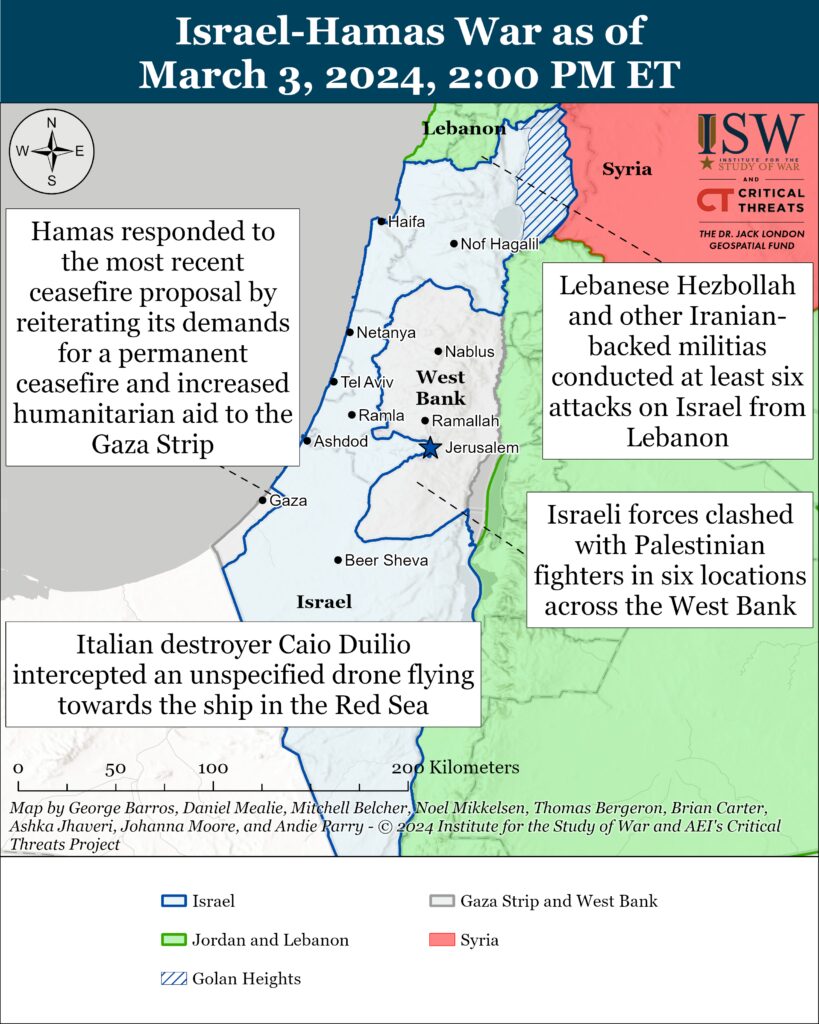
Gaza Strip
Axis of Resistance campaign objectives:
Erode the will of the Israeli political establishment and public to launch and sustain a major ground operation into the Gaza Strip
Degrade IDF material and morale around the Gaza StripThe Israel Defense Forces (IDF) concluded a two-week long operation in Zaytoun neighborhood, southeastern Gaza City on March 3.[i] Israel launched the operation on February 20 to re-clear Hamas fighters from Zaytoun.[ii] Palestinian militias sustained a high attack rate targeting Israeli forces throughout the operation and likely infiltrated the area from uncleared areas in the central Gaza Strip.[iii] The IDF reported on March 3 that its 162nd Division killed over 100 fighters and destroyed Hamas- and Palestinian Islamic Jihad-affiliated military sites.[iv]
Palestinian fighters continued to attack Israeli forces in Zaytoun on March 3. The continued Palestinian militia attacks demonstrate that Israeli forces have not fully cleared Zaytoun and Palestinian militias in southern Gaza City likely retain some capacity to fight despite the official end of the re-clearing effort.[v] The al Aqsa Martyrs’ Brigades, which is the self-proclaimed military wing of Fatah and aligned with Hamas in the war, claimed several attacks targeting Israeli forces in Zaytoun and south of the neighborhood using rocket-propelled grenades and mortars.[vi]
Palestinian Mujahideen Movement fighters fired an anti-tank rocket targeting an Israeli tank east of Jabalia.[vii]
Israeli forces expanded clearing operations in Khan Younis on March 3.[viii] The IDF Air Force conducted a wave of airstrikes as part of shaping efforts to enable ground maneuvers.[ix] Local footage and reports confirmed that the IDF expanded operations to a pocket of uncleared area in Qarara in northern Khan Younis and Hamad neighborhood in northwestern Khan Younis.[x] Hamas’ Qarara Battalion in the Khan Younis Brigade remains combat effective.[xi] Palestinian journalists reported that the IDF set up a checkpoint in Hamad neighborhood and told civilians to evacuate to the Mawasi humanitarian zone or Deir al Balah.[xii]
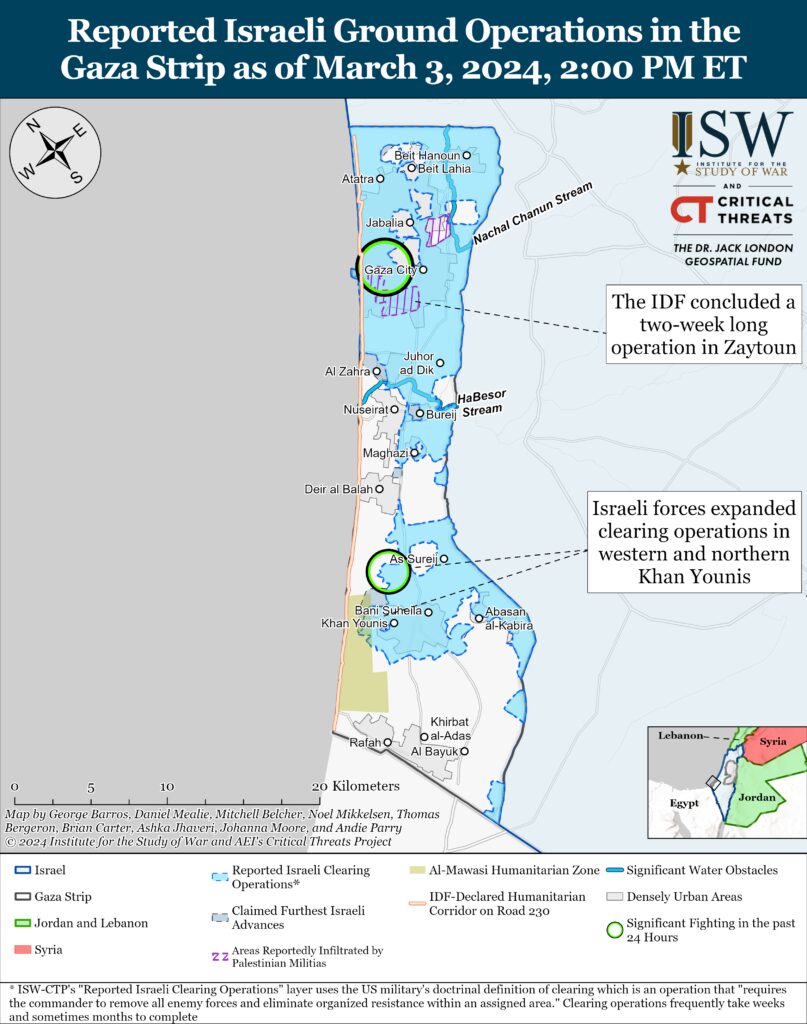
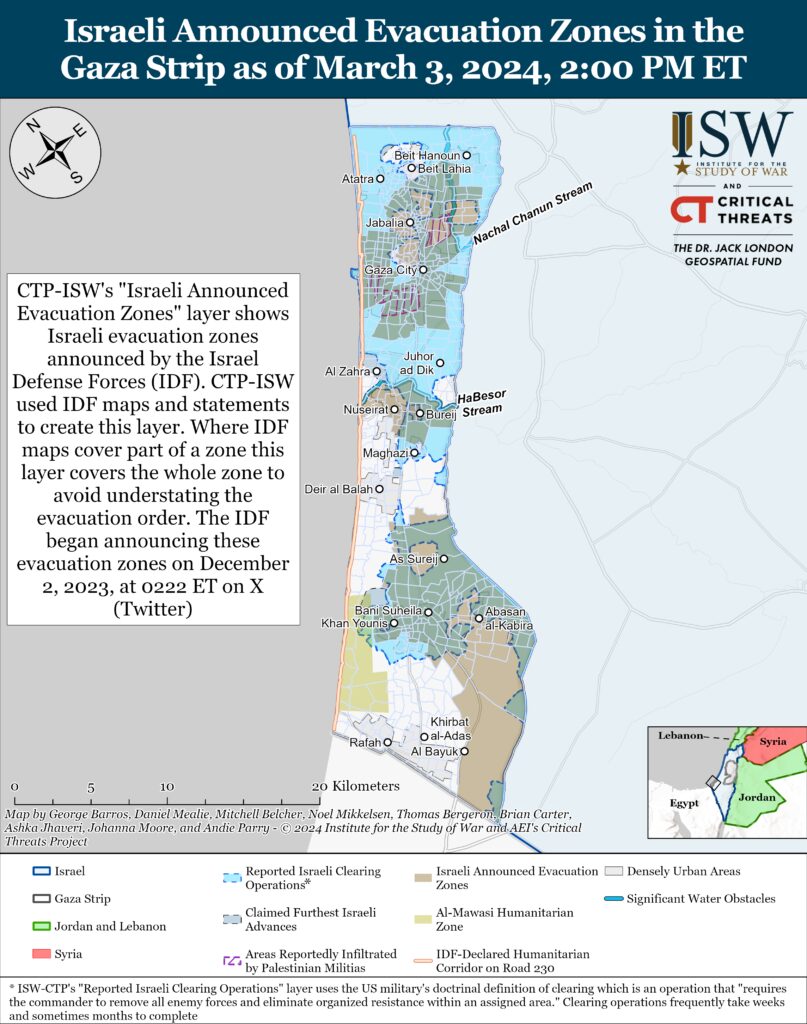
Hamas responded to the most recent ceasefire proposal with demands for a permanent ceasefire and increased humanitarian aid to the Gaza Strip. This is consistent with Hamas’ prior demands during ceasefire negotiations. International mediators have been waiting on a response from Hamas regarding the February 23 framework that included a six-week pause in fighting and the release of 400 Israeli-held Palestinian prisoners in exchange for Hamas releasing 40 Israeli hostages.[xiii] Israel has reportedly accepted the proposal.[xiv] An Israeli official told Israeli media on March 3 that Israel received an answer from Hamas about the framework. The official said that Hamas did not in its answer address Israel’s demand to receive information on the status of the hostages it holds in the Gaza Strip and how many Palestinian prisoners Israel must release for every hostage freed.[xv] A senior Hamas official told an unspecified Qatari newspaper that Hamas “will not provide any details about the abductees it is holding without significant relief [for]…the residents of Gaza and the application of a comprehensive ceasefire.”[xvi]
A “highly placed” diplomatic source told CNN that Hamas would not agree to any hostage deal without Israel agreeing “to [a] permanent ceasefire or at least a path to a ceasefire,” an Israeli withdrawal from the Gaza Strip, and allowing Gazan civilians to reenter the northern Strip.[xvii] Hamas is also demanding a certain amount of aid reach the southern and northern strip before agreeing to a deal. The source assessed that it is unlikely they will reach a deal in the next 48 hours.
A Hamas delegation arrived in Cairo on March 3 for ceasefire talks that US and Egyptian negotiators are also expected to attend.[xviii] An unspecified senior Hamas source confirmed to CNN that the delegation arrived. The official refused to confirm any details about the groups’ position, noting that what is being reported is “speculation and leaks.” It is unclear what parts of Hamas’ reported position the official was referring to. Israeli negotiators were initially expected to attend the talks in Cairo. However, unspecified Israeli officials stated on March 3 that Israel would not send a delegation to Cairo after Hamas reiterated its demands for a permanent ceasefire.[xix]
Two US sources told Axios that US President Joe Biden urged Qatari and Egyptian leaders to “get a deal” from Hamas before the start of Ramadan.[xx] Biden spoke with the leaders on February 29 to discuss ceasefire negotiations. Ramadan is expected to begin on March 10. Israeli officials, including War Cabinet member Benny Gantz, have warned that Israeli forces will begin clearing operations in Rafah at the start of Ramadan if Hamas does not release the remaining Israeli hostages the group holds.[xxi]
Palestinian fighters conducted three indirect fire attacks from the Gaza Strip into southern Israel on March 3.[xxii]
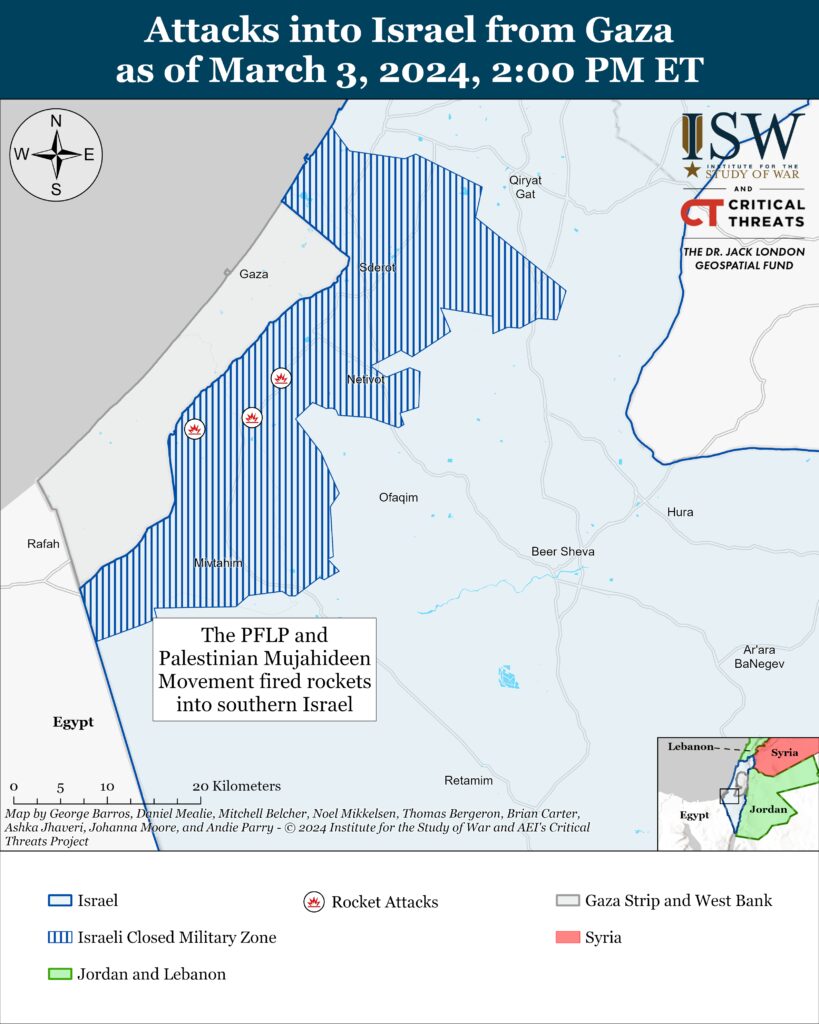
Recorded reports of attacks; CTP-ISW cannot independently verify impact.
West Bank
Axis of Resistance campaign objectives:
Draw IDF assets and resources toward the West Bank and fix them thereIsraeli forces have clashed with Palestinian fighters in six locations across the West Bank since CTP-ISW’s last data cutoff on March 2.[xxiii]
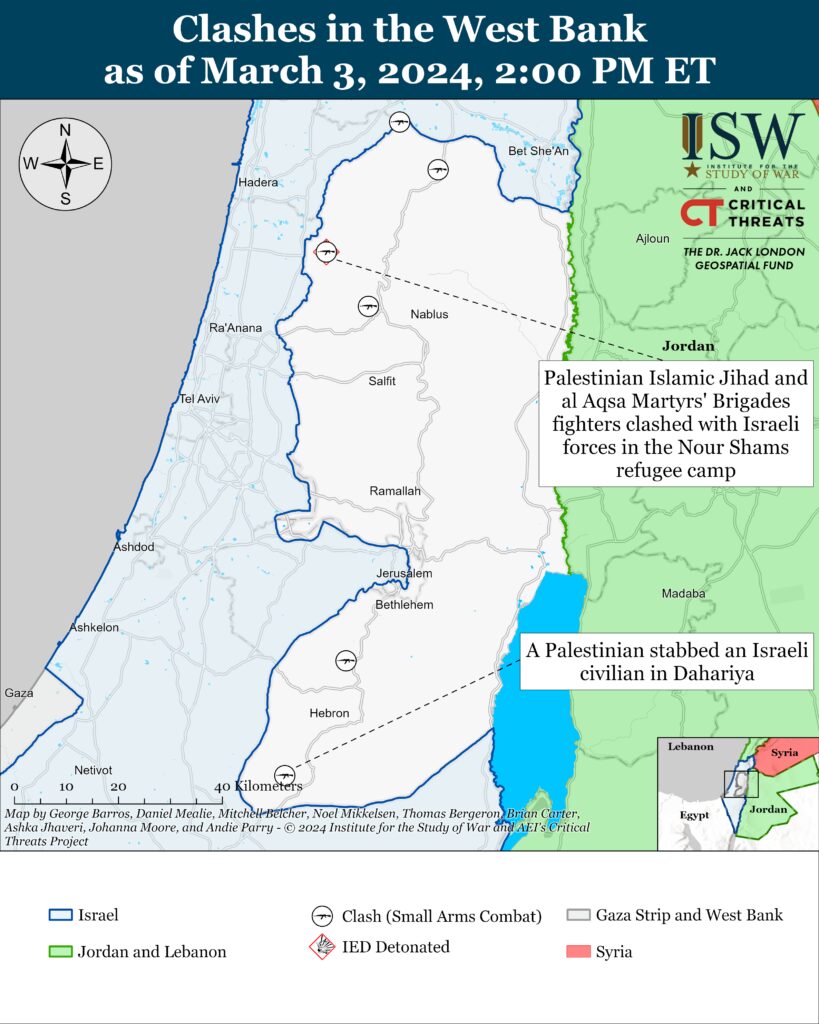
This map is not an exhaustive depiction of clashes and demonstrations in the West Bank.
Southern Lebanon and Golan Heights
Axis of Resistance campaign objectives:
Draw IDF assets and resources toward northern Israel and fix them there
Set conditions for successive campaigns into northern IsraelIranian-backed militias, including Lebanese Hezbollah, have conducted at least six attacks from southern Lebanon into northern Israel since CTP-ISW’s last data cutoff on March 2.[xxiv]
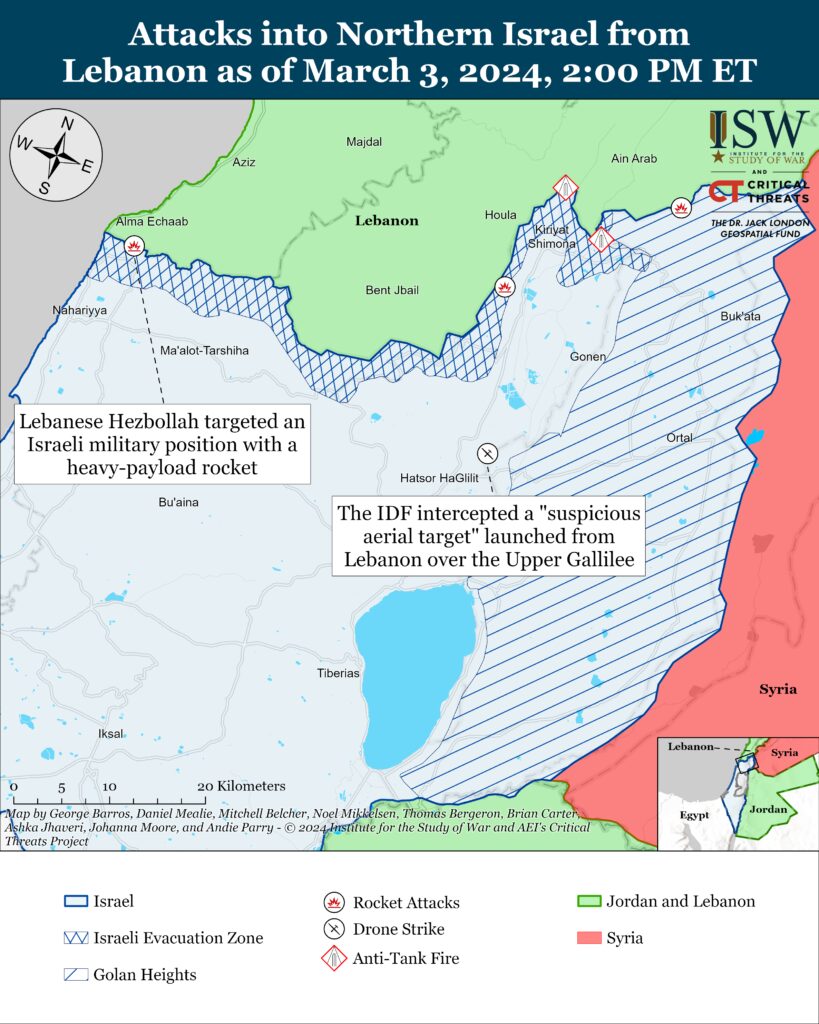
Recorded reports of attacks; CTP-ISW cannot independently verify impact.
Iran and Axis of Resistance
Axis of Resistance campaign objectives:
Demonstrate the capability and willingness of Iran and the Axis of Resistance to escalate against the United States and Israel on multiple fronts
Set conditions to fight a regional war on multiple frontsThe Islamic Resistance in Iraq—a coalition of Iranian-backed Iraqi militias—claimed a drone attack targeting a chemical plant at the Haifa Port on March 1.[xxv] The group announced the attack on March 3. The IDF did not report a drone attack on Haifa on March 1, but an Israeli journalist reported that the IDF did shoot down a ”suspicious aerial target” over the city on February 29.[xxvi] The Islamic Resistance in Iraq last attacked Israel on February 12 in the Golan Heights.[xxvii] The group has not claimed an attack on US forces since February 4 but has continued attacks targeting Israel.[xxviii]
Italian destroyer Caio Duilio intercepted an unspecified drone flying towards the ship in the Red Sea on March 2.[xxix]
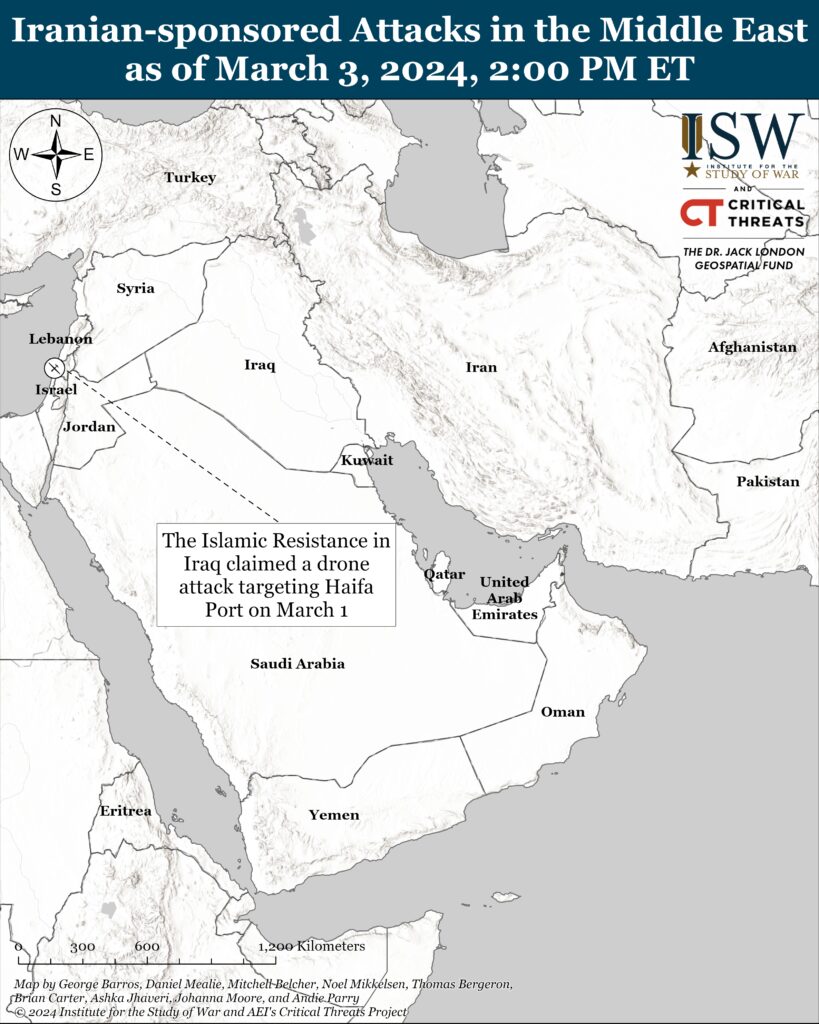
 Eurasia Press & News
Eurasia Press & News




